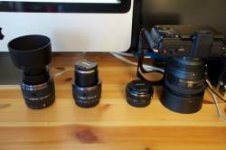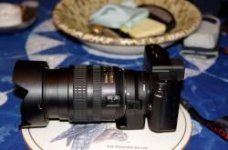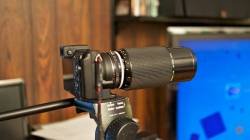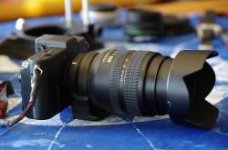I never thought I would ever buy a Nikon, nor a handful of Nikon lenses, but I have. As a Pentax man I was disappointed with the Pentax Q, but then Nikon introduced their first mirrorless, exchangeable lens, camera (Variously called an EVIL, CSC or just, in the case of Nikon, Series 1.
In 2011 Nikon introduced the Nikon 1 series of cameras, that are compact-sized, mirrorless cameras, with exchangable lenses. Rugged, with a body made of magnesium, and surprisingly heavy, they seem to be made to last a lifetime.
Their 'CX' sensors are just 10MP, and just slightly smaller than the 'micro fourthirds' sensors, so the lenses are a bit smaller than those for those cameras. There are two models, J1 and V1, the former lacking viewfinder of any kind.
The cameras have one of the quietest shutters there is (the V1 has two!), and the kit lenses have VR (vibration control), except the 10/2.8 prime.
The V1 can take many shots very quickly, and movies in AVCHD format, and the autofocus is lightning fast.
The V1 (and the J1) can be equipped with a Nikon adapter, so that any G series lens can be used, with their built-in vibration reduction, and autofocus.
As the sensor is so small, it has a magnification factor of 2.7 (a DX/APS-C camera has a factor of 1.5, a MFT 2.0), compared to a full-frame/FX camera. So the tele zoom goes from 30-110, or 81 to 297mm, in full frame terms.
Quickly the V1 has become a darling of bird photographers, some using up to 600mm lenses - that's comparative to a 1620mm focal length on a full-size camera. A steady tripod is then a must!
Nikon AF G lenses (with built-in motor) work excellently, when used with the TF1 adapter, even the lenses's VR, if they are so equipped.
Modern Sigma lenses, with VR (aka OIS), does not work at all, but non-VR does!
In 2011 Nikon introduced the Nikon 1 series of cameras, that are compact-sized, mirrorless cameras, with exchangable lenses. Rugged, with a body made of magnesium, and surprisingly heavy, they seem to be made to last a lifetime.
Their 'CX' sensors are just 10MP, and just slightly smaller than the 'micro fourthirds' sensors, so the lenses are a bit smaller than those for those cameras. There are two models, J1 and V1, the former lacking viewfinder of any kind.
The cameras have one of the quietest shutters there is (the V1 has two!), and the kit lenses have VR (vibration control), except the 10/2.8 prime.
The V1 can take many shots very quickly, and movies in AVCHD format, and the autofocus is lightning fast.
The V1 (and the J1) can be equipped with a Nikon adapter, so that any G series lens can be used, with their built-in vibration reduction, and autofocus.
As the sensor is so small, it has a magnification factor of 2.7 (a DX/APS-C camera has a factor of 1.5, a MFT 2.0), compared to a full-frame/FX camera. So the tele zoom goes from 30-110, or 81 to 297mm, in full frame terms.
Quickly the V1 has become a darling of bird photographers, some using up to 600mm lenses - that's comparative to a 1620mm focal length on a full-size camera. A steady tripod is then a must!
Nikon AF G lenses (with built-in motor) work excellently, when used with the TF1 adapter, even the lenses's VR, if they are so equipped.
Modern Sigma lenses, with VR (aka OIS), does not work at all, but non-VR does!







